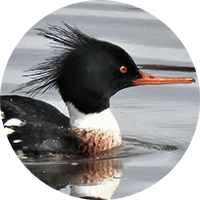Red-breasted Merganser
Appearance: Red-breasted Mergansers are medium-sized (58 cm - 23 inches) diving ducks with a slim, streamlined body and a long, serrated bill. Males have a striking appearance, featuring a slate-gray body, a reddish-brown neck, and a dark green head with a white chin patch and shaggy crest. Long thin reddish bill. Females, on the other hand, have a brownish-gray body with a reddish-brown head and a distinct shaggy crest. Neck is gray on chest.
Habitat: These ducks are found near coastal areas and large inland waters. They prefer habitats such as lakes, rivers, estuaries, and bays, where they can easily access their main food source—fish. They are also known to inhabit brackish water bodies. Fresh or saltwater. Flows low and dives in deep water.
Behavior: Red-breasted Mergansers are voracious fish eaters and skilled divers. They propel themselves underwater using their webbed feet and pursue fish with their long, narrow bills. They are known for their agile and rapid swimming abilities. When disturbed, they can take off directly from the water, unlike some other diving ducks that require a running start.
Breeding: They build their nests in dense vegetation near water bodies, on the ground or in elevated areas. The female constructs the nest using plant material and down feathers. A clutch contains 6-10 eggs, which hatch after an incubation period of around 25-30 days.
Conservation Status: The Red-breasted Merganser is listed as a species of Least Concern by the International Union for Conservation of Nature (IUCN).
Distribution
Colombia, being located in South America, falls outside the natural range of the Red-breasted Merganser. The duck's preferred habitats include freshwater lakes, rivers, estuaries, and coastal areas with access to fish-rich waters. While there may be rare sightings or occasional vagrant individuals outside their regular range, it is not considered a native or resident species in Colombia. It is a visitor to Islas San Andrés y Providencia.
Taxonomy
- Kingdom: Animalia
- Phylum: Chordata
- Class: Aves (birds)
- Order: Anseriformes
- Family: Anatidae
- Genus: Mergus
- Species: Mergus serrator
Vocalization
Calls: During the breeding season, male Red-breasted Mergansers produce a low, croaking call to attract females. It often sounds like a soft, rolling "croo-croo-croo" or "grrrr" sound.
Aggressive Calls: When threatened or during territorial disputes, Red-breasted Mergansers may emit aggressive calls to ward off rivals or predators. These calls can include harsh, guttural croaks or growls.
Contact Calls: Red-breasted Mergansers use contact calls to maintain social cohesion and communicate with each other. These calls are typically soft and can be described as a series of soft "urk" or "khurk" notes.
Alarm Calls: When Red-breasted Mergansers perceive danger, they emit sharp, high-pitched calls to alert their flock or nearby individuals. These alarm calls are rapid, repetitive, and can be described as "kit-kit-kit" or "wiik-wiik-wiik."
Display Calls: During courtship displays, both males and females produce unique vocalizations. Males often emit a series of low, growling calls, while females respond with softer, higher-pitched whistles or cooing sounds.




